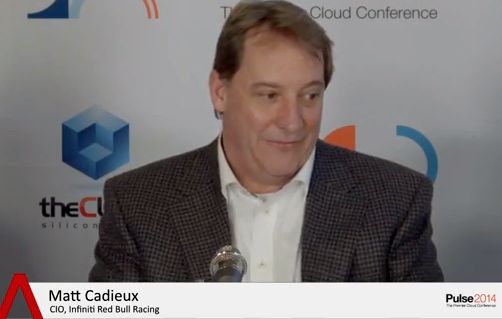 NEWS
NEWS
 NEWS
NEWS
 NEWS
NEWS
![]() Pulse 2014, IBM’s ongoing cloud event hailing from Las Vegas, is bringing together the luminaries of the tech world, exploring the strategic technology trends for 2014. Two we’re looking at during this week’s broadcast include the new era of workloads, and the trends driving the IT transformation to software-defined environments.
Pulse 2014, IBM’s ongoing cloud event hailing from Las Vegas, is bringing together the luminaries of the tech world, exploring the strategic technology trends for 2014. Two we’re looking at during this week’s broadcast include the new era of workloads, and the trends driving the IT transformation to software-defined environments.
Matt Cadieux, Infinity Red Bull Racing’s CIO, joined John Furrier and Dave Vellante in theCUBE, to discuss how their internal cloud infrastructure, powered by SDE, helped innovate the racing competition.
“Let’s talk about technology meeting racing,” invited Furrier.
Cadieux proceeded to elaborate on Red Bull Racing’s method of applying data science in the auto racing field.
“My team is responsible for the applications and the underlying infrastructure that we use to design, make and race Formula 1 cars,” stated Cadieux. “We have over 200 applications in the company and we make heavy use of simulations for things like computation fluid dynamics to design the shape of the car, we use data analytics to make the right decisions during the race events, our infrastructure has hundreds of servers and over 4 petabytes of managed data.”
Cadieux also mentioned “a very sophisticated network” and the private cloud that allows them to meet the business demands for simulations and data analytics – with the help of IBM platform computing.
“Everything is data-driven – from inception, design, build,” said Furrier who then asked Cadieux to talk the viewers through the magnitude of the data. “What’s the CIO’s challenge?”
.
Red Bull Racing relies heavily on simulation, modeling, and virtual analysis to design the winning car, and the IT infrastructure is a critical component of the competitive advantage.
“The cars are instrumented, we have over 100 sensors on them, plus engineers at the track looking at telemetry. But we also have an MPLS connection back to an operations room. There are 20 engineers consuming telemetry. My big challenge is to make sure all of the infrastructure works and engineers get the data they need in a timely fashion so that they can make the right decisions,” answered Matt Cadieux.
Furrier asked for a specific example where Cadieux relied on real-time data to perform a tweak or a significant game-changing detail.
“The most compelling example we have was in 2012 when Sebastian Vettel was trying to win the Drivers Championship and was involved in an accident during his last lap. The car was damaged and we had to micro-manage the car for the entire length to do just well enough in order for him to finish and win the race.”
“With the real time feeds, we were able to look at the general stats and instruct Sebastian how to nurse the car and finish the competition. That’s the most high-profile example of data analytics that made a big difference to the race’s outcome,” said Cadieux.
“What would you have done differently, without this instrumentation?” asked the co-hosts.
“Vettel had to change the engine mode because the exhaust had been dented,” said Cadieux. “If he pushed the car as hard as possible, the exhaust would have cracked and he wouldn’t have finished,” he admitted. “During the pit stop we also had to adjust the wings angles to adjust the ballance on the car. All this was done at the advice of the people doing the simulation.”
“How far has this come in the last 10 years?” inquired Vellante.
“Ten years ago it would not have been possible,” admitted Matt Cadieux. “We started some seven years ago, taking baby steps and adding to the infrastructure in increments. We couldn’t do without it today; it’s a big differentiator.”
“Talk about a tooling and the infrastructure a little bit,” asked Vellante.
“With telemetry we can do a lot of sophisticated post-processing on a grid computer, to understand what our cars are doing and to develop a strategy. We can also get a very good idea on what our competitors are doing, figuring out what their weaknesses are and how we can exploit them,” bragged Cadieux.
“You built your own private cloud. What does it look like?” theCUBE co-hosts wondered.
“We have two types of super computers that are based on grid computing,” detailed Cadieux.
1. We work with IBM Platform Computing so the environments are all defined by software, we use Linux clusters and LSF and we do a lot of simulation for computational fluid dynamics to design the shape of the cars. The shape of the car evolves with every race. We focus on new parts, new updates – depending on the track that we’re going to. The big LSF based clusters run big CFD (computational fluid dynamic) simulations.
2. The other type of cluster that we set up is the Symphony cluster, and we use it to do a lot of the data analytics applications that we use real-time at the tracks.”
“We don’t rely so much on the gut feeling, but we do rely still on experienced engineers and we try to give them better data so that they can make better decisions,” commented Cadieux.
Furrier asked him if he can name some of the current pressures on the CIOs today.
“Formula 1 is a very technology-based sport, and because technology touches every part of the company, from the design to manufacturing and analytics, everybody wants to continually improve. We are also under a lot of pressure to improve our applications and improve the capability of our infrastructure. That’s why cloud computing really helps out; it gives us the ability to scale up our infrastructure to meet all the incremental demands.”
THANK YOU